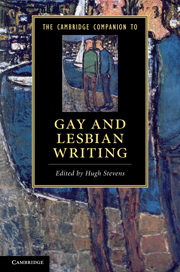Book contents
- Frontmatter
- Homosexuality and literature: an introduction
- Part I Repression and Legitimation
- Part II Affiliations
- 6 The homoerotics of travel: people, ideas, genres
- 7 The queerness of race and same-sex desire
- 8 The literature of AIDS
- 9 Transgender fiction and politics
- Part III Literary Traditions
- Guide to further reading
- Index
8 - The literature of AIDS
from Part II - Affiliations
Published online by Cambridge University Press: 28 January 2011
- Frontmatter
- Homosexuality and literature: an introduction
- Part I Repression and Legitimation
- Part II Affiliations
- 6 The homoerotics of travel: people, ideas, genres
- 7 The queerness of race and same-sex desire
- 8 The literature of AIDS
- 9 Transgender fiction and politics
- Part III Literary Traditions
- Guide to further reading
- Index
Summary
This chapter considers the breadth, volume, diversity and appeal of works of literature in English which have engaged with the medical syndrome AIDS - Acquired Immune Deficiency Syndrome - since the first evidence of its spread in 1981. It cannot hope to be representative in terms of the global impact of the AIDS epidemic for a simple reason. Though the scale of HIV/AIDS in many non-Western societies is far greater than in Europe or America, non-Western literary and cultural manifestations of AIDS have been scarce. Equally, though many non-English cultures have seen an impressive, substantial body of AIDS-related literature emerge, I have focused on texts written or made in English. With the exception of a few French, Italian and Spanish authors and filmmakers - Cyril Collard, Hervé Guibert, Pier Vittorio Tondelli, Ferzan Ozpetek, Pedro Almodovar and Juan Goytisolo - non-English texts have had a small circulation, rarely being translated or distributed in the English-speaking world. This relative invisibility holds true for works in English published in countries outside the USA, UK, Ireland and Canada, such as South Africa, Australia or New Zealand. For reasons of space, I have restricted myself mostly to British and American texts in a number of genres, which illustrate key tendencies, and to some lesser-known or untypical works, as well as to some critical and theoretical responses, both to the syndrome and to its cultural representations.
- Type
- Chapter
- Information
- The Cambridge Companion to Gay and Lesbian Writing , pp. 132 - 147Publisher: Cambridge University PressPrint publication year: 2010

